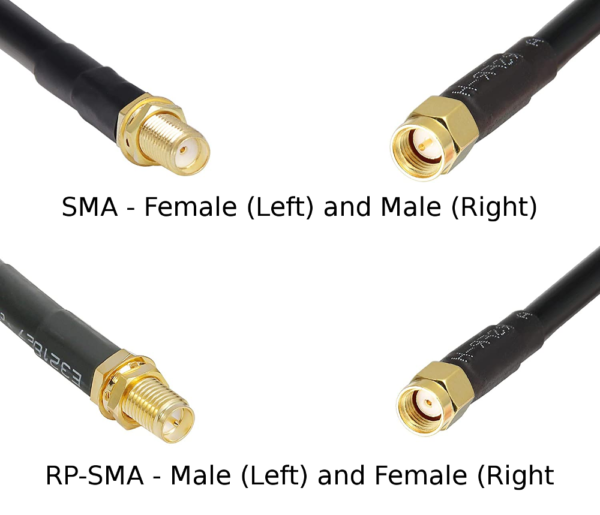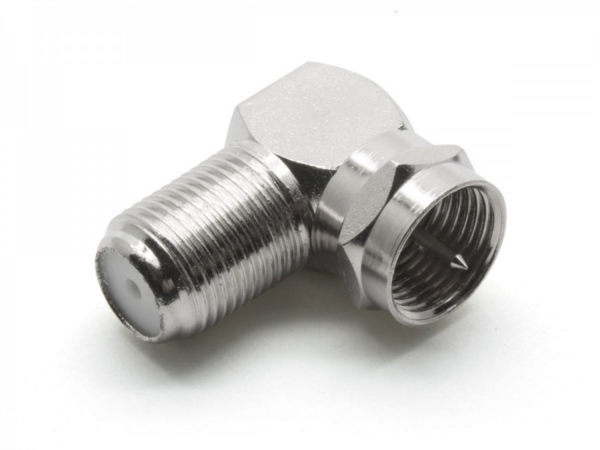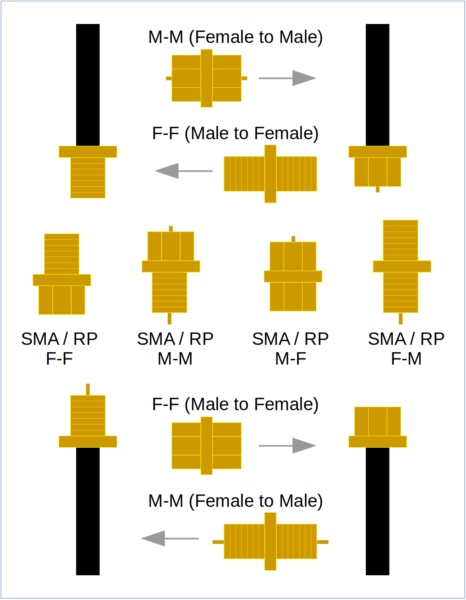Rant: SMA vs. RP-SMA
A few years ago, I put up a wireless camera system, and I ended up needing an antenna extension cable.
I vaguely recall buying a SMA, and it was the wrong one, which of course meant that I had to buy a RP-SMA cable, which worked.
I have also occasionally had to buy RP-SMA cables to extend WiFi antennas from time to time – mainly due to line-of-sight issues.
And I never gave it much thought after that.
Having recently installed a new gate opener, I found that I needed to raise the antenna (again, due to line-of-sight issues), and I bought a RP-SMA cable, which I assumed was fairly standard.
Imagine my surprise when it didn’t work – ONE end connected just fine, but the other end wouldn’t connect at all.
“What idiot used the wrong standard?”, I thought to myself.
So I bought a SMA cable, and that worked out just fine.
However, I started thinking about it. Why have two cables that are otherwise identical, but not interoperable?

Other than the pin configuration, SMA and RP-SMA are identical. In regular SMA, the male pin goes on the female-threaded connector. In “Reverse Polarity” SMA, the male pin goes on the male-threaded connector.
What is SMA?
The SubMiniature A (SMA) connector is a smaller, lighter-weight, and more precision version of the “F” connector.
If you’ve ever had a VCR or cable box in the 1990’s, you have at least one of these in the bottom of a drawer somewhere:

The venerable “F” connector at the end of a coaxial cable was once the standard way to connect devices that share a NTSC video signal. Over time, this was replaced by newer standards, but even as late as the early 2000’s, you could go purchase a VCR, and it probably came with one of these cables.
The pin on the male end is typically the unshielded cable’s core, which protrudes from the insulation. The male end has a female thread that freely spins, while the female end has fixed male threads. To connect the two, you insert the pin in to the female end, and tighten the free-spinning “nut” on the male end. Here is an RG59 elbow that has both male and female F connectors:

RG59 (“F” Connector) Elbow
The SMA connector is slightly smaller, lighter, and machined to more specific tolerances.

SMA Elbow
If you were unaware of the scale, SMA connectors look almost identical to F connectors. However, where the female F connector is about 1/3 inch in diameter, the female SMA connector is about 1/4 inch – about 32% smaller.
Today, SMA connectors are found almost universally in any consumer application that uses an external antenna, including hand-held radios, FRS (walkie-talkies), garage door openers, and WiFi routers.
Well, not WiFi routers.
This is where RP-SMA comes in.
What is RP-SMA?
I always assumed that one or the other supported better attenuation, or more bandwidth, or maybe one was for outdoor applications. But, that’s not the case.
“Reverse Polarity” SMA, or RP-SMA, was created as a way to appease the FCC’s requirement to keep people from being able to boost their WiFi signal by attaching a larger antenna.
I wish I was kidding.
You see, when WiFi was first standardized in 1997, the FCC required “unlicensed transmitters” to use an antenna connector that was either proprietary, or required professional installation.
In order to address the FCC requirement, some genius decided to move the pin on the then-standardized SMA connector from the female-threaded end to the male-threaded end. So RP-SMA should really be called “Reverse Gender” SMA – polarity refers to the signal, and gender refers to the connector.
As an easy fix, the larger manufacturers adopted RP-SMA as an alternative to SMA, because inventing an entirely new connector would be unavoidably complicated and unreliable.
Because all of the larger WiFi manufacturers used RP-SMA, it became fairly standard, and because it became fairly standard, parts and cables eventually made their way in to the consumer market. And once the parts and cables hit the consumer market, it was no longer considered proprietary.
So, just 3 years later in 2000, the FCC dropped the “unique and proprietary” requirement, because RP-SMA was no longer unique, and no longer proprietary. And by that time, WLAN was fairly standardized, and the government had other things to worry about.
Unfortunately, the legacy of those bad decisions is that we have two incompatible but semi-interoperable standards.
Why RP-SMA is Bad
In summary, there is too much complexity, which leads to too many possibilities for problems.
In my case, I didn’t even know that I had the wrong cable until I went to connect the two male ends together.

SMA is on the top, RP-SMA is on the bottom. In addition to the two gender changers for SMA and the two for RP-SMA, there are four additional converters between the two. Also, RP-F is mechanically-compatible with SMA-F, but won’t pass a signal because there is no center pin on either connector.
Because the two standards use the same mechanical connection, it’s way too easy to mistake one for the other. In addition to two gender changers for each, there are four additional converters, which means that there are eight possible combinations instead of the usual three (M-M, F-F, M-F) that you would find with any other connector.
Worse, you can connect a female RP-SMA to a female SMA, but it won’t pass a signal because there is no pin.

For example, if I didn’t know better, and simply bought a RP-F to SMA-F coupler, I could have spent weeks troubleshooting, and I bet others have done this.
It’s a bad standard, and now that the FCC no longer requires it, RP-SMA should be completely deprecated in favor of SMA, which was the original standard.
(And besides, “Reverse Polarity” SMA is not even named correctly)
How Do We Get Rid of RP-SMA?
- Stop making devices with RP-SMA connectors. Eventually all of the old devices will die off.
- Stop making RP-SMA cables. Make ONLY SMA cables, and continue to produce converters for situations where a cable needs to connect to an older RP-SMA device.
As with most pin-based connectors, devices that use either SMA or RP tend to have female connectors, because pins bend, and replacing a bent pin on a device is a lot more expensive than simply replacing a cable. Further, most antenna cables tend to be male-to-female, and antennas tend to be male. Therefore, for most applications, converting RP to SMA would only require a RP-male to SMA-female connector, and then everything after that, including the antenna, would be SMA.
For example, if you look at the max frequency of SMA connectors, it’s usually around 6 GHz, but RP-SMA connectors go higher, over 10 GHz. I’ve worked several years in the electronic component industry and am an active amateur radio operator.
Interesting – I was not aware of the frequency difference between the two. My experience is that the two are virtually the same, just gender-bended. In many cases, the two are made from identical parts, and use identical cables, etc. However, if we were to pick RP-SMA as the superior standard, then my argument is the same – we should dump the other standard! :-)
You make many excellent points here, but one counterargument may be worth considering. SMA connectors are often used in relatively low UHF and VHF applications, and RP-SMA connectors are used in higher frequency microwave or even mmwave applications. Different coax cable standards have substantially different loss characteristics at different frequencies, that make proper connector and coax cable selection very important. Using incompatible connectors between lower and higher frequency applications should help ensure devices are set to appropriately for their applications and work as intended.
Today I learned RP-SMA existed.
I’ve used SMA for years in a physics lab setting. Recently I decided I wanted to relocate the antennas on a home wifi router and always figured they were just SMA connectors. That’s what they look like. Well today the SMA cables I ordered arrived and I was annoyed to see the nut was on the wrong end.
Finding your page helped me figure out what to actually order. I agree with your solution. RP-SMA should die.